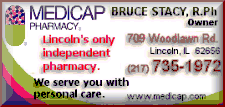|
You can lower your chances of getting heart disease. One way
is to choose foods carefully.
For a healthy heart, eat:
-
Less fat.
-
Less sodium.
-
Fewer calories.
-
More fiber.
Eat less fat
Some fats are more likely to cause heart disease -- saturated
fats and trans fats. These fats are usually found in foods from
animals, such as meat, milk, cheese and butter. Saturated and trans
fats also are found in foods with palm and coconut oils. Eat less of
these foods.
Eat less sodium
Eating less sodium can help lower some people's blood pressure.
This can help reduce the risk of heart disease.

Sodium is something we need in our diets, but most of us eat too
much of it. Much of the sodium we eat comes from salt we add to our
food at the table or that food companies add to their foods. So,
avoid adding salt to foods at the table.
Eat fewer calories
When we eat more calories than we need, we gain weight. Being
overweight can cause heart disease. When we eat fewer calories than
we need, we lose weight.
Eat more fiber
Eating fiber from fruits, vegetables and grains may help lower
your chances of getting heart disease.
Diet tips for a healthy heart
-
Eat a diet low in
saturated fat, especially animal fats and palm and coconut oils.
-
Add foods to your
diet that are high in monounsaturated fats, such as olive oil,
canola oil and seafood.
-
Eat foods
containing polyunsaturated fats found in plants and seafood.
Safflower oil and corn oil are high in polyunsaturated fats.
-
Choose a diet
moderate in salt and sodium.
-
Maintain or improve
your weight.
-
Eat plenty of grain
products, fruits and vegetables.

Instead of this, do this:
-
Instead of whole or
2 percent milk and cream, use 1 percent or skim milk.
-
Instead of fried
foods, eat baked, steamed, boiled, broiled or microwaved foods.
-
Instead of lard,
butter, palm and coconut oils, cook with unsaturated vegetable
oils, such as corn, olive, canola, safflower, sesame, soybean,
sunflower or peanut oil.
-
Instead of fatty
cuts of meat, such as prime rib, eat lean cuts of meat or cut
off the fatty parts.
-
Instead of one
whole egg in recipes, use two egg whites.
-
Instead of sour
cream and mayonnaise, use plain low-fat yogurt, low-fat cottage
cheese, or low-fat or "light" sour cream.
-
Instead of sauces,
butter and salt, season vegetables with herbs and spices.
-
Instead of regular
hard and processed cheeses, eat low-fat, low-sodium cheeses.
-
Instead of salted
potato chips and other snacks, choose low-fat, unsalted tortilla
and potato chips and unsalted pretzels and popcorn.
[to top of second
column]
 |

Read the food label
The food label can help you eat less fat and sodium, fewer
calories, and more fiber.
Look for certain words on food labels. The words can help you
spot foods that may help reduce your chances of getting heart
disease. The FDA has set rules on how these words can be used. So,
if the label says "low-fat," the food must be low in fat.
Look at the side or back of the package. Here, you will find
"Nutrition Facts." Look for these words:
-
Total fat
-
Saturated fat
-
Cholesterol
-
Sodium
Look at the "% Daily Value" listed next to each term. If it is 5
percent or less for fat, saturated fat, cholesterol and sodium, the
food is low in these nutrients. That's good. It means the food fits
in with a diet that may help reduce your chances of getting heart
disease.
Tips for losing weight
-
Eat smaller
portions.
-
Avoid second
helpings.
-
Eat less fat by
staying away from fried foods, rich desserts and chocolate
candy. Foods with a lot of fat have a lot of calories.
-
Eat more fruits and
vegetables.

Eating for a healthy heart
You can lower your chances of getting heart disease. One way is
through your diet.
Remember:
-
Eat less fat and
sodium.
-
Reduce your
calories if you're overweight.
-
Eat more fiber.
-
Eat a variety of
foods, including plenty of bread, rice, cereal, fruit and
vegetables.
-
If you drink beer,
wine or other alcoholic beverages, do so in moderation.
Some other things you can do
Ask your doctor to check your cholesterol level. This is done
with a blood test. The test will show the amount of cholesterol in
your blood with a number. Below 200 is good. The test will also show
the amount of "good" and "bad" cholesterol. Your doctor can tell you
more about what these numbers mean.
If your cholesterol is high, your doctor may suggest diet
changes, exercise or drugs to bring it down.
Regular exercise -- such as walking, swimming or gardening -- can
help you keep your weight and cholesterol down.
You will find an abundance of recipes to meet your new goal of
eating healthy by checking "Cooking
the Heart-Healthy Way."
For more information
-
If you have
questions, you can call your nearest FDA office. Look for the
number in the blue pages of the phone book.
-
Or call the FDA's
toll-free food information line at 888-SAFEFOOD (723-3366).
-
Or look for the FDA
on the Internet at www.fda.gov.
The Food and Drug Administration is an agency of the U.S.
Department of Health and Human Services that makes sure that foods
are safe, wholesome and honestly labeled.
Department of Health and Human Services
Food and Drug Administration
5600 Fishers Lane (HFI-40)
Rockville, MD 20857
[U.S. Food and Drug Administration] |